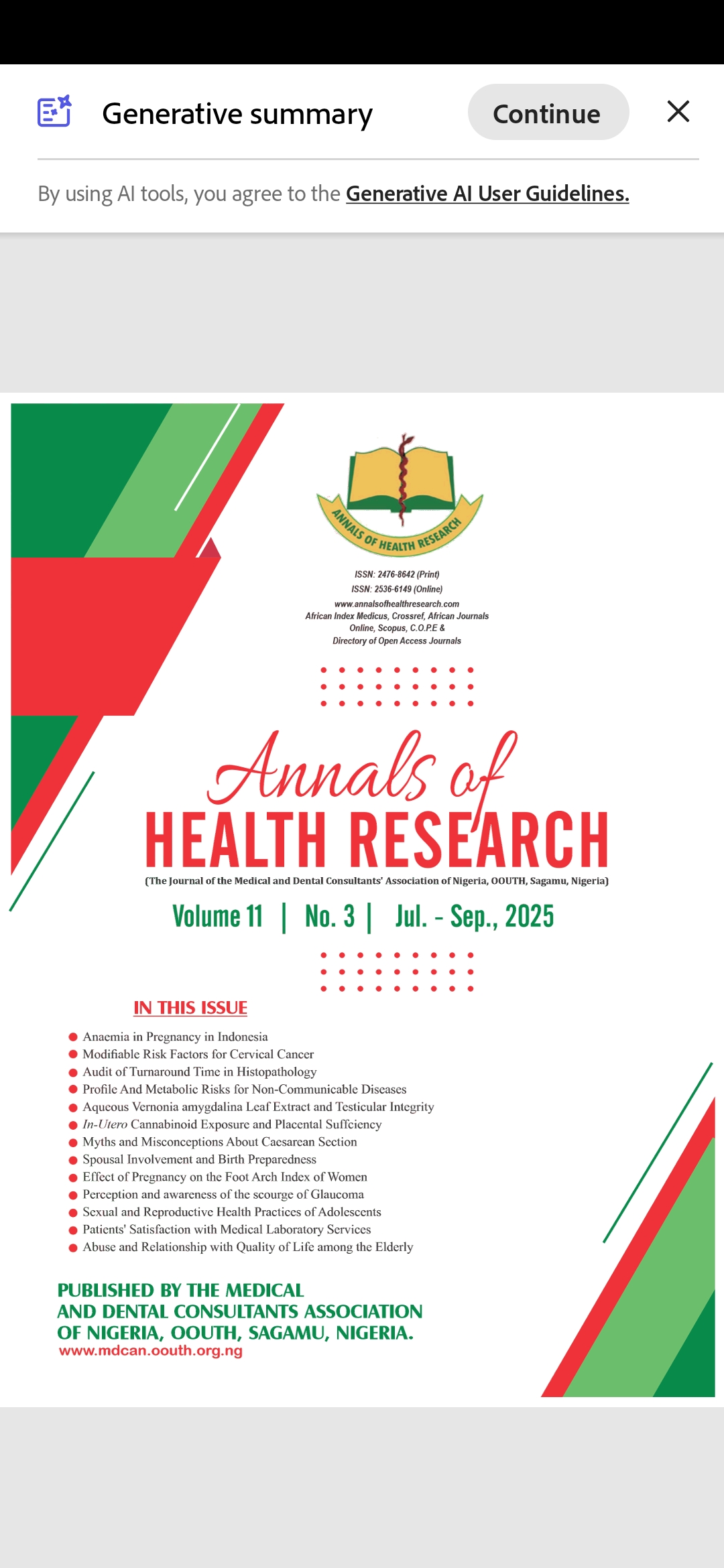Comparative Study of Modifiable Risk Factors for Cervical Cancer Among Female In-School Adolescents in Osun State
DOI:
https://doi.org/10.30442/ahr.1103-02-289Keywords:
Adolescence, Cervical cancer, Secondary school, Human Papillomavirus, Risky behaviourAbstract
Background: Adolescents make up about one-fourth of Nigeria's population, and most are engaged in risky sexual activities that have serious health consequences later in life. Understanding the risk factors for the development of cervical cancer is essential for promoting health-related behaviours. Therefore, it is a public health priority as cervical cancer presents a significant public health challenge in Nigeria.
Objectives: To assess and compare awareness and knowledge of modifiable risk factors (MRF) of cervical cancer among in-school female adolescents in secondary schools in both rural and urban areas of Osun State.
Method: A comparative, cross-sectional study was conducted among 400 adolescents in rural and urban areas (200 per group) of Osun State, Nigeria, who were recruited using the multistage sampling technique. Quantitative data were collected using a semi-structured questionnaire.
Results: Most respondents from both rural and urban areas had not heard of human papillomavirus (77%), cervical cancer (67%), and MRF for cervical cancer (64.5%). However, awareness of these topics was slightly higher among urban dwellers compared to rural dwellers. Additionally, most respondents from both metropolitan areas (114, 57.0%) and rural areas (132, 66.0%) had poor knowledge, with a statistically significant difference (p = 0.04).
Conclusion: This study revealed that residence in rural and urban locations significantly influenced awareness and knowledge about the human papillomavirus, cervical cancer, and related MRF. Culturally appropriate communication programs and targeted educational interventions for cervical cancer are therefore recommended.
References
1. Igras SM, Macieira M, Murphy E, Lundgren R. Investing in very young adolescents’ sexual and reproductive health. Global Public Health 2014;9:555–569. https://doi.org/10.1080/17441692.2014
2. Kim Y. Adolescents’ health behaviours and its associations with psychological variables. Cent Eur J Public Health 2011;19:205–209. https://doi.org/10.21101/cejph.a3694.
3. Toye MA, Okunade KS, Roberts AA, Salako O, Oridota ES, Onajole AT. Knowledge, perceptions and practice of cervical cancer prevention among female public secondary school teachers in Mushin local government area of Lagos State, Nigeria. Pan Afr Med J 2017;28. https://doi.org/10.11604/pamj.
4. Mustafa M, Ajaz NA, Illzam E, Sharifa AM, Suleiman M, Yanggau B. Risk Factors for Cervical Cancer : Diagnosis and Management. J Dent Med Sci 2016;15:104–110. https://doi.org/10.9790/0853-150608104110
5. Okunade KS, Salako O, Adenekan M, Sunmonu O, Salawu K Sekumade A, Daramola E OG-NJGP. The uptake of cervical cancer control services at a cancer information service center in Lagos, Nigeria. Niger J Gen Pract 2018;16:20–24. https://doi.org/10.4103/NJGP.NJGP_21_17
6. Makwe C. C., Anorlu R. I. OKA. Human papillomavirus (HPV) infection and vaccines: knowledge, attitude and perception among female students at the University of Lagos, Lagos, Nigeria. J Epidemiol Glob Health [Internet]. 2012;2:199–206. https://doi.org/10.1016/j.jegh.2012.11.001
7. Kumakech E, Andersson S, Wabinga H, Musubika C, Kirimunda S, Berggren V. Cervical cancer risk perceptions, sexual risk behaviours and sexually transmitted infections among Bivalent Human Papillomavirus vaccinated and non-vaccinated young women in Uganda - 5 year follow-up study. BMC Women's Health 2017;17:1–12. https://doi.org/10.1186/s12905-017-0394-y
8. Ndikom CM, Oboh PI. Perception, acceptance and uptake of human papillomavirus vaccine among female adolescents in selected secondary schools in Ibadan, Nigeria. Afr J Biomed Res 2017;20:237–244. https://doi.org/32209425.
9. Oluwole EO, Idowu OM, Adejimi AA, Balogun MR. Knowledge, attitude and uptake of human papillomavirus vaccination among female undergraduates in Lagos State, Nigeria. J Commun Med Primary Health Care 2019;8:3627–3633. https://doi.org/10.4103/jfmpc.jfmpc 520 19
10. Famutimi E, Oyetunde M. Risky Sexual Behaviour among Secondary School Adolescents in Ibadan North Local Government Area, Nigeria. OSR J Nurs Health Sci 2014;3:34–44. https://doi.org/10.9790/1959-03343444
11. Moore AR, Driver N. Knowledge of Cervical Cancer Risk Factors Among Educated Women in Lomé, Togo : Half-Truths and Misconceptions. SAGE Open 2014;1:10. https://doi.org/10.1177/2158244014557041
12. Osun State Government. Osun State in Brief. [Website] Osogbo: Bureau of Computer Services and Information Technology, Osun State [Internet]. 2009 [cited 2017 Jul 17]. Available from: http://osunstate.gov.ng/geography.htm].
13. Federal Republic Of Nigeria. Official Gazette of the 2006 National Population and Housing Census; The Federal Government Printer, Lagos, Nigeria, FGP71/52007/2, 500 (OL24). 2007;94:175–98.
14. Osun State ministry of education in Brief. [Website] Osogbo: Bureau of Computer Services and Information Technology, Osun State [Internet]. 2009 [cited 2017 Jul 17]. Available from: http://osunstate.gov.ng/geography.htm].
15. Asaduzzaman S, Chakraborty S, Hossain Mg, Bashar Mi, Bhuiyan T, Paul Bk, et al. Hazardous Consequences of Polygamy, Contraceptives and Number of Children on cervical cancer in a low-income country: Bangladesh. Cumhuriyet Sci J 2016;37:74.
16. Cervical-Cancer-Nga-2021-Country-Profile-En (1). 2021 https://cdn.who.int/.
17. Healton CG, Gritz ER, Davis KC, Homsi G, McCausland K, Haviland ML, et al. Women’s knowledge of the leading causes of cancer death. Nicotine Tobacco Res 2007;9: 761–768. https://doi.org/10.1080/14622200701397916.
18. Ezeanochie M, Olasimbo P. Awareness and uptake of human papillomavirus vaccines among female secondary school students in Benin City, Nigeria. Afr Health Sci 2020;20:45–50. https://doi: 10.4314/ahs.v20i1.8
19. Anorlu R, Adegbesan M, Adaramewa T. Knowledge of HPV and cervical cancer among HIV-positive women in Lagos, Nigeria. Infect Agent Cancer 2010;5:9378. https://doi.org/10.1186/1750-9378-5-S1-A46.
20. Stein CJ, Colditz GA. Modifiable risk factors for cancer. Vol. 90, Brit J Cancer 2004;90:299–303. https://doi.org/10.1038/sj.bjc.6601509
21. Diorgu FC, Diorgu KN. Awareness of HPV Infection and Vaccination Among Teens in Urban Schools, Nigeria. Gynecol Reprod Health 2021;5. https://doi.org/10.33425/2639-9342.1151
22. Olofinbiyi BA, Adefisan AS, Olumuyiwa AJ. The level of awareness of cervical cancer and its prevention among adolescents of public high schools in a high-risk Nigerian population. Int J Med Sci Clin Res Rev 2020;3:298–313.
Downloads
Published
Issue
Section
License
Copyright (c) 2025 Annals of Health Research (The Journal of the Medical and Dental Consultants Association of Nigeria, OOUTH, Sagamu, Nigeria)

This work is licensed under a Creative Commons Attribution-NonCommercial 4.0 International License.
The articles and other materials published in the Annals of Health Research are protected by the Nigerian Copyright laws. The journal owns the copyright over every article, scientific and intellectual materials published in it. However, the journal grants all authors, users and researchers access to the materials published in the journal with the permission to copy, use and distribute the materials contained therein only for academic, scientific and non-commercial purposes.


